Flight Officer Ron Jenkins & "Lady Orchid"
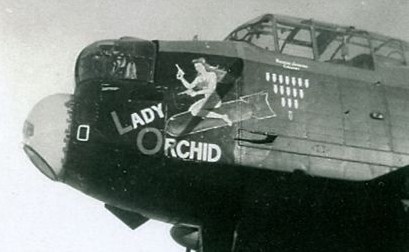
WL-O serial # KB-895, 434 Squadron. (Photo courtesy - Clarence Simonsen)
In the summer of 1993, Clarence Simonsen began research into the history of Ronnie Jenkins and his Lancaster bomber called "Lady Orchid". The research idea was a two-part project, first the Aero Space Museum of Calgary needed money, and second, Clarence would like to see the Calgary Lancaster painted in the colours of Lady Orchid to honour Calgarian Ronnie Jenkins.
He completed a replica nose art on original Lancaster skin and this went to auction on 5 November 1993, at the Calgary Convention Centre. The daughter of Ron Jenkins purchased five tickets to the event at $100 per ticket and had the winning bid of $1,000.00 for her father's replica nose art which The Aero Space Museum of Calgary received.
Clarence had researched the history on “Lady Orchid” and Ron Jenkins and in May 2003 the story was published in "Flightlines" the publication of Canadian Warplane Heritage Museum in Hamilton, Ontario.
I would like to thank Clarence Simonsen for providing a complete article on "Lady Orchid". Equally important the research into the life of F/O Ron Jenkins; born in Calgary, served his country, preserved history, and instrumental in providing the City of Calgary with strength for the future.
by Clarence Simonsen – Nose-Artist
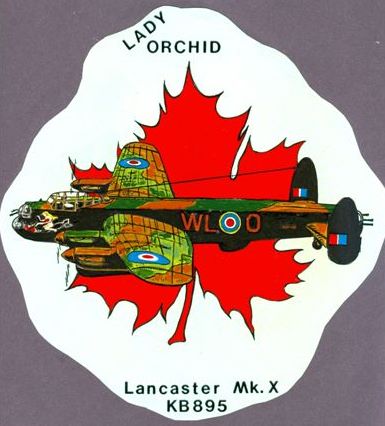
During World War Two, 73% of the RCAF active bombing operations (28,126), were flown by the Handley Page Halifax bomber. Over 17,000 personnel in the RCAF gave their lives in the service of Canada. The major overseas casualties came from Bomber Command where 8,240 personnel were killed on active operations, most flying in the Halifax aircraft. No. 6 (RCAF) Group lost 812 aircraft, 127 Wellington, 149 Lancaster and 508 Halifax bombers. During 40 years of interviews with Canadians who flew both the Halifax and Avro Lancaster on operations, some still insist the Halifax was the superior bomber. It is no exaggeration to state the Halifax was far superior to the Lancaster in one area – painting and preservation of No. 6 ([RCAF) Group Canadian Nose Art.
On 11 April 1945, F/L Harold Hunter Lindsay arranged for the removal of fifteen - Seventeen actual Nose Art panels from the Canadian flown Halifax bombers. The Nose Art, salvage work was carried out by Mr. Robert Goodwin, of New Earswick, Yorkshire, England. The panels arrived in Ottawa on 7 May 1946 and today fourteen still remain in the total collection.
This is the largest collection of original Halifax Nose Art in the world and second only to the Americans collection in total original Nose Art panels.
While the Americans have one complete museum dedicated to their Nose Art collection (Midland, Texas) the Canadian collection was never displayed as a complete unit until the new War Museum (Ottawa, Canada) opened on 8 May 2005.
The first Canadian Lancaster Mk. X (more than one aircraft) operation took place on 27 April 1944, target –Montzen, Belgium. No. 419 (Moose) Squadron flew eight new Canadian Lancaster X’s and five Halifax bombers. This was the only time the squadron flew an operation with more than one type of aircraft, and the last Halifax lost by the squadron, (Pilot P/O R.A. McIvor). No. 419 (Moose) Squadron carried out the most bombing raids and flew the most sorties of all No. 6 (RCAF) group Lancaster Mk. X squadrons. These early Moose squadron Lancaster crews saw fierce combat action, set Canadian records and painted some of the best Lancaster Canadian Nose Art.
The Andrew Mynarski V.C. Lancaster [Canadian Warplane Heritage] records forever the story of the Lancaster KB726 and crew on the fateful night of 12/13 June 1944, but sadly the bomber carried no Nose Art to go with the history. Well that is not completely correct as part of FM213 forever carries the center section from KB895 which featured Canadian Nose Art history from Calgary, Alberta.
Henry Marshall Jenkins grew up on a farm in the heart of Prince Edward Island potato country. As a teen he grew bored with the picking and sacking of the endless rows of suds. For pure adventure Henry came up with an idea of placing a note in each sack of potatoes, asking the recipient to write back to him, telling of the place they lived. When a letter arrived from a western town named Calgary, Henry was hooked and saved to purchase a one-way train ticket west. In June 1909, Henry stepped from the train and just two months later formed a partnership with store owner John Irwin with “Jenkins and Crowfoot” groceries opening at what is today 9th Avenue and the Calgary Zoo turn-off.
The hard working Henry married in 1911 and a new son was born on 8 July 1913, named Ronald Henry Jenkins. Ronnie grew up around the grocery store business, while attending Earl Grey and Western Canada High Schools. In 1929 Ronnie joined the family business “Jenkins Grocerteria” which now consisted of seven stores, a bakery and a wholesale grocery branch.
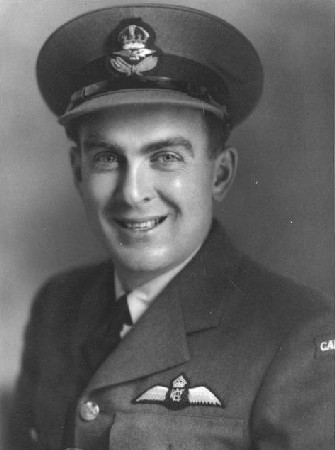
At age 29 Ron Jenkins left the family business to join the Royal Canadian Air Force, and became recruit LAC Jenkins R178132, reporting to No. 4 Initial Training School at Edmonton on 18 April 1943. The British Commonwealth Air Training Plan reached its peak output in October 1943, when 5,157 aircrew graduated. One of these students authorized to wear a pilot flying badge was Flying Officer Ronald Henry Jenkins J36968 of the RCAF. F/O Jenkins was posted overseas for further training and arrived with No. 434 (Bluenose) Squadron on 21 December 1944.
One British and two Canadian Lancaster bombers carried the code letters WL-O in Bluenose squadron during World War Two. The first Canadian built Lancaster (KB850) was delivered in 1944 after first serving with No. 419 (Moose) squadron. On 17 January 1945, it was reported missing on a raid to the oil refinery at Zeitz, Germany.
The next Lancaster to wear WL-O became a Mark I, built by Vickers-Armstrong, Chester, England, wearing serial PA225. Ron Jenkins crew flew Lancaster PA225 on 3, 7, 9, 26 and 27 February then again on 2, 7, 8, 10, 14 and 20 March 1945. PA225 was transferred to No. 429 (Bison) Squadron on 28 March 45.
On 2 April 1945, a new Canadian built Lancaster Mk X serial KB895 aircraft was air-tested by Ron Jenkins and crew;
Navigator - F/O Savage A.W. #J28963
Bomb Aimer - F/O Hines P. J. #J38296
Wire Operator - F/Sgt. Mc Lean N. #R165106
Engineer - Sgt. Foss D. C. #R202282
Rear Gunner - Sgt. Baird T. B. #R21186
Mid-Upper - F/Sgt. Moodie K. #R200478
Upon completion of the testing Wing Commander J.C. Mulvihill informed Jenkins the new bomber, serial KB895, would become his bomber with code WL-O. The crew now decided “their” bomber needed a name and Nose Art painting. At first they named her “Wee Lady Orchid” for each of the code letters, then later dropped the Wee and she became “Lady Orchid”.
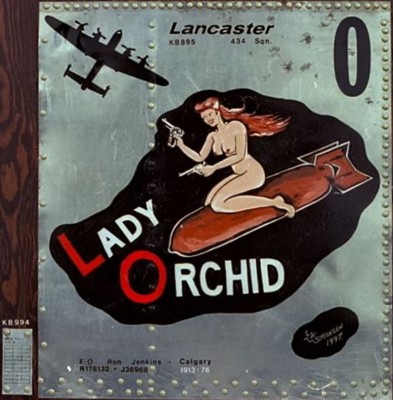 "KB-895 WL-O "Lady Orchid"
"KB-895 WL-O "Lady Orchid"Pilot Jenkins painted the name in large white letters with a larger red capital L and O. The complete crew then shared in the painting of the Lady Godiva pin-up riding a bomb while holding two Calgary Western style six shooters. The bomber nose art lady was painted fully nude, and completed her first operation on 4/5th April 45, to attack the synthetic oil plants at Leuna, Germany.
F/O Jenkins flew a total of fifteen operations with 434 Squadron in Lancaster aircraft, five in his Lady Orchid, last to Bremen on 22 April 1945. Under his pilot position he painted fifteen white bombs and one red bomb for one aborted operation.
On Friday, 13 April 1945, Flight Lieutenant Ron Jenkins and crew flew operation No. 13 to Kiel, Germany. Twice Jenkins had to dive and corkscrew from German night fighter attacks.
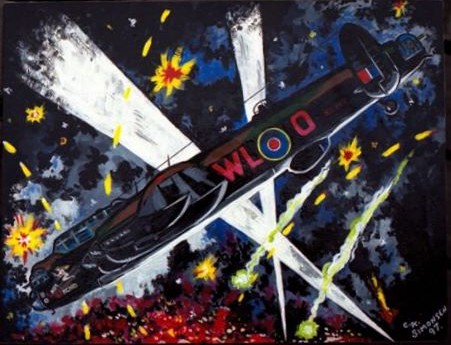
(Donated to Aero Space Museum of Calgary - not on display)
Lady Orchid flew her last mission on 25th April piloted by F/O Bonar to Wangerooge. Other members of this crew; F/O H.G. Hall, F/O W.T. Perry, F/Sgt. A.E. Sully, F/Sgt. R.G. Smith, Sgt. J. Noonan, and Sgt. L.P. Churchill.
On 7 June 45, No. 434 Squadron left Croft, England, for the transatlantic flight to Canada, and for this return, two red Maple Leafs, were painted on the upper torso of Lady Orchid. On 17 June, Lady Orchid and crew landed at Dartmouth, Nova Scotia, and 37 days leave.
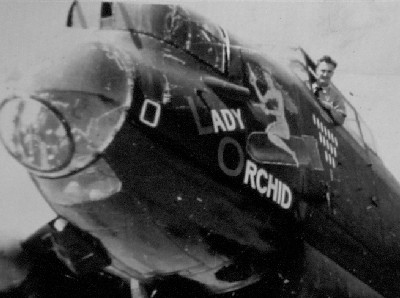
The photo shows ground crew member Fred Bendus in the cockpit of Lady Orchid just before departure for Canada. Note - the red Maple Leafs have been painted over the nude Lady Orchid.
The atomic bombing of Hiroshima and the second bomb on Nagasaki ended World War Two, resulting in the disbanding of “Tiger Force” on 5 September 45.
The Canadian Government had no requirements for a large bomber force, so orders were given to place hundreds of Lancaster bombers into long-term storage. The veteran KB series Lancaster aircraft (many with Nose Art) were ordered to Western Canada, with stop over in Toronto, and RCAF Station Gimli, Manitoba, for fuel.
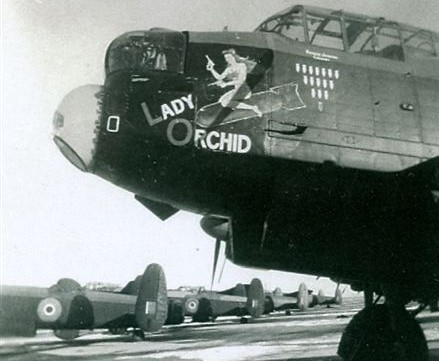
On 8 September 45, eighty-three Lancaster aircraft arrived at Pearce, Alberta, the final stop until they were ferried to their respective storage depots in Alberta. In the next six months they were placed into long-term storage from Penhold, Alberta (North) to Medicine Hat, Alberta (South).
Lady Orchid (KB895) remained in service with No. 2 Air Command from 11 September 45 to 22 January 1947. Struck off charge by the RCAF the aircraft was flown to Penhold, Alberta, by F/L H. Buocher and turned over to War Assets. On 12 April 1947, Ron Jenkins arranged for War Assets to reserve his old bomber for him, which he purchased for two hundred and thirty dollars. Ron then ordered each station point in the bomber removed, which he mailed to each of his old crewmembers.
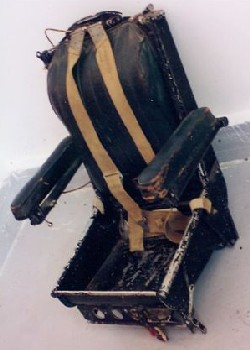
The bomber was then returned to War Assets who re-sold the Lancaster to a local Penhold farmer who had ideas to turn it into a machine shop, tool shed. By 1952 the Lancaster had been raised up onto three cement columns, but the farmer had lost interest in his project.
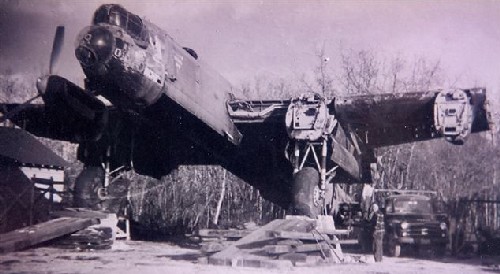
Lancaster sitting on 3-columns
In 1947 the Canadian Government decided to sell off many of the Lancaster bombers stored in Alberta. Each bomber sold just below the $400 range. A High River, Alberta farmer, Mr. Albert Hoving purchased 44 complete bombers from Crown War assets; twenty-one came from Pearce, and twenty-three from Penhold. He also purchased twenty Merlin engines and tons of spare parts, which were stored at the old base in High River. He intended to melt the bombers and sell the aluminum for pots and pans.
In 1950 the Canadian Government needed the old Lancaster bombers for anti-submarine maritime patrol, as the Cold War was coming to the East coast of Canada. The company, “Found Brothers” Aviation of Malton, Ontario, were attempting to get their single engine bush plane into production and needed cash. When they heard the Government wanted to buy back the bombers they left for Alberta and scouted out the aircraft purchased by local farmers. In total the found Brothers purchased fifty World War Two Lancaster bombers at a price of $1000 each. They then sold the same aircraft back to the Canadian Government at market value of $10,000 per airframe plus twenty Merlin engines and spare parts which had been at High River, were sold to Avro and de Havilland. The $600,000 profit from the sale was used to develop the Found Brothers FBA-2 bush plane.
The Found Brothers had also looked at the Lancaster [KB895] Lady Orchid at Penhold, but found it in too poor a condition to purchase for re-sale to the Government.
By 1950, 70 Lancaster Mk X aircraft had been modified by A.V. Roe Canada Ltd, for post-war service in the RCAF. In the next two years design work began on the Canadian C-102 Jetliner, and full production began on the CF-100 Canadian fighter jet. Due to lack of space and manpower a number of Lancaster X conversions were now sub-contracted to de Havilland Aircraft of Canada. On 28 August 1950, FM213 and nine other bombers were dismantled and taken by road to the Downsview, Ontario, aircraft plant. When the conversion work was completed FM213 was flight tested in January 1952, then assigned to No. 405 Squadron at Greenwood, Nova Scotia. On 24 January the modified Lancaster was flown to Trenton, Ontario, by a partial crew when no regular ferry crew was available. On landing the crew stalled the bomber over the runway, lost control, ground-looped and then the starboard undercarriage collapsed. The centre-section was damaged so bad the RCAF feared it was a complete write-off. When the inspection team checked the Lancaster they reported repairs could be made but a complete centre-section would have to be found. There were no other centre-sections in Canada according to RCAF records but Bud Found recalled the farmer in Penhold, Alberta.
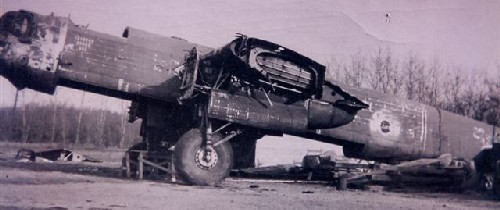
Lancaster KB-895 at Penhold Alberta, 1952

A phone call was made and the farmer was willing to sell Lady Orchid (KB895). Soon afterwards a flatbed truck heading for Penhold railyard with centre section of "Lady Orchid"
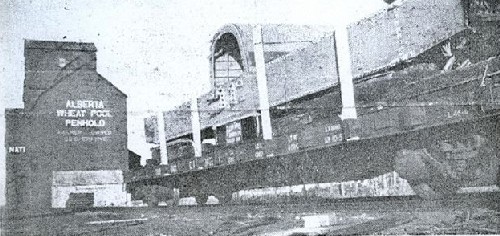
"The experience and ingenuity of technicians from Found Bros. Combined successfully to tackle the job. Many problems and much hard work – a story in itself – had to be faced before the centre-section was safely removed and cradled ready for rail shipment to Toronto."
The largest railway flat-car in Canada was sent from New Brunswick to Penhold, Alberta, in order to carry the centre-section to Downsview.
The new section was inserted into the mid-section of FM213 in July 1953, and test flown by Bob Fowler on 26 August. The rest is history as FM213 went on to fly ten years with No. 107 Composite Unit at Torby, Newfoundland, and today flies as KB726, VR-A, known to all as the Mynarski Lancaster.
Well-known Calgary businessman, Ron Jenkins passed away in Holy Cross hospital on 30 April 1976, age 62 years.
Mr. Jenkins was president and general manager of the following…
Louis Petrie Ltd.,
Store Properties Ltd.,
Comrentals Ltd.,
Commercial Equipment Ltd.,
Glencoe Buildings Ltd.
President of the following…
Burritt Travel Service Ltd.,
Glendale Properties Ltd.,
Dejay Investments Ltd.,
Rocar Leasing Co. Ltd.,
Kenron Building Ltd.
Member of the advisory board of Canada Permanent Trust Co.
Best known for his association with the Harry Hays Stampede breakfast, plus associate director of the Calgary Stampede.
Honorary president of the YMCA.
On the board of directors for the United Fund and Chamber of Commerce.
Past President of the Calgary Rotary Club and founder of the South Calgary Rotary Club.
Past president of the Petroleum Club and Calgary and District Community Foundation.
Member of the Ranchmen's Kanukeena and Glencoe Clubs.
Director of the Calgary Flying Club.
On the board of directors of the CNIB.
The following items from Lancaster KB-895 were donated to the Aero Space Museum of Calgary.
- Original instrument panel has been restored and is in the Calgary Lancaster FM-136.
- Pilot seat from “Lady Orchid” (not on display)
- Log book (missing).
- Painting – “Lady Orchid in corkscrew” (Clarence Simonsen collection - not on display).
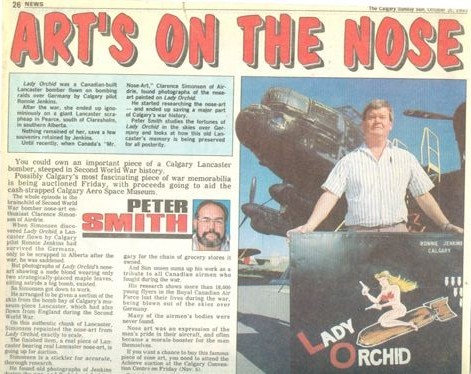
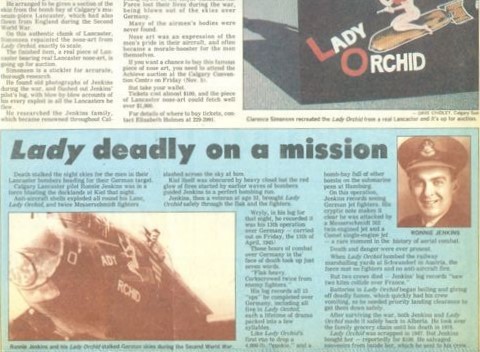
On Saturday 27 June 1989, the author stood for two, then three hours waiting for the arrival of the Mynarski Memorial Lancaster at Calgary International Airport.
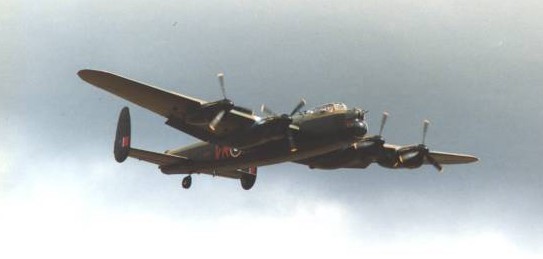
Mynarski Lancaster arriving over Calgary 27 June 1989.
When the moment arrived, I heard and saw my first Lancaster bomber, but my mind could only think of Ron Jenkins and how his centre-section from Lady Orchid had passed over a farm at Penhold and now came home to Calgary, Alberta. What were the odds?
The Americans have the only nose art museum in the world at Midland, Texas. This contains the largest original collection of nose art in the world, at 33. The Canadian War Museum has the second largest collection in the world with 14 original Halifax nose art panels in Ottawa.
This museum has a number replica RCAF and RAF nose art, along with one original WW II nose art panel and three replica nose art panels painted by two WW II nose artists (Muff Mills painted two panels and Floyd Christmas painted the German 434 titled "Death by Night".)

